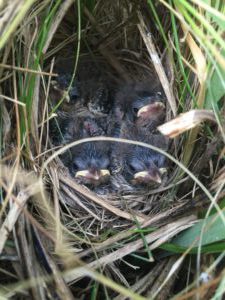Share this article
Sea level rise and predation threaten saltmarsh sparrow population
Seaside (Ammodramus maritimus) and saltmarsh sparrows (A. caudacutus) have a lot in common. Both spend virtually their entire lives along coastal salt marshes, and both face similar threats to their nests from predators and flooding. One species seems more at risk from local extinction due to current rates of predation, but both will face the negative consequences of sea level rise long-term, according to a recent study.
In a study published in Condor: Ornithological Applications, researchers looked at how these two Atlantic Coast salt marsh obligate species are faring in the Edwin B. Forsythe National Wildlife Refuge in New Jersey and how they will respond to projected climate change-induced sea level rise and predator management scenarios.
They found that the saltmarsh sparrow population was likely to disappear from the refuge under sea level rise scenarios, while seaside sparrows persisted.

A nest full of saltmarsh sparrows. The vegetation is wet due to tides, and the nest, which is located only a few centimeters off the ground, is vulnerable to flooding and predation. ©Sam Roberts
“The initial finding was basically that seaside sparrows are stable,” said Samuel Griffith Roberts, a research associate at the University of Delaware and lead author of the study. “They seem like they’re going to have fairly stable population trends within his location, whereas saltmarsh sparrows will potentially go extinct within this location in the next 20 or so years.”
But Roberts says he worries that because the two are “sister species” that share so much in common, the extinction of one could predict the fate of the other. Due to their similar habitat and breeding needs, he said, seaside sparrows “are likely going to follow suit with saltmarsh sparrow declines.”
Over five years, from 2011 to 2015, Roberts and his colleagues went into the field and collected demographic data for both species during breeding seasons. They located and monitored nests of both species throughout the season, allowing them to estimate annual nestling production, rates of nest failure and the causes of failed nests. Predation was the primary cause of most failures, followed by failure due to nest flooding. Each year they also captured and banded as many adult sparrows as possible, in addition to banding nestlings.
Using this information, along with a variety of other demographic estimates, they created models using population viability analysis to project what the future would look like for the two sparrows.
The team created scenarios with low and high levels of sea level rise using existing Sea Level Affecting Marshes Model — or SLAMM — projections to predict how much habitat loss a sea level rise of 1 foot and 2 ½ feet would cause for both sparrows. Then, they looked at different predator control scenarios and how that might affect the birds.

Seaside sparrows populations are currently fairly stable. ©fishhawk
In both sea level rise scenarios, Roberts and his team found that seaside sparrows were stable, while saltmarsh sparrows became locally extinct within the 42-year model.
Predator control could help both species, researchers found, but that presents a problem. Biologists don’t know yet what is preying on the nests.
“That is the big question I kept coming back to,” he said. “If we knew that, we could do a lot more and potentially slow the declines we have projected. But it turns out we have very little information about predator identity.”
Roberts and his colleagues think it could be anything from gulls, herons and egrets to mink (Neovison vison), raccoons (Procyon lotor) or even coyotes (Canis latrans), but due to the harsh condition of salt marshes, pinpointing the identity and quantity of nest predators is a challenge.
“New Jersey has a large amount of high quality salt marsh habitat for both species, and a large percentage of the breeding population of saltmarsh sparrows is in New Jersey,” he said. “Short-term predator management may be a good solution, but long-term, sea level rise will continue to shrink the available habitat and alter the tidal regimes that both species have specialized in surviving.”
Header Image: An adult saltmarsh sparrow. Saltmarsh sparrows are likely to go locally extinct in a New Jersey refuge in 20 years. ©Sam Roberts








